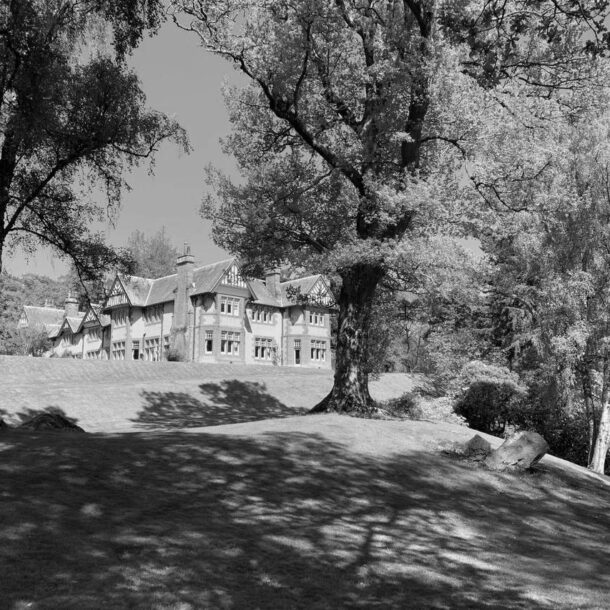

Close

The 18th century may be best known as the Age of Reason, but it was also a time when philosophers extolled pleasure as a right and hedonism became thoroughly fashionable.
One epicenter of this Epicurean worldview was just steps away from Orlagh. From the house, you can see the ruins of a hunting lodge on top of a hill where the Irish Hell-Fire Club gathered in the 1700s. The club united aristocratic libertines who wished to practice their debauchery in like-minded company. They were men who proudly called themselves rakes. The word “rakehell” emerged in the 16th century to refer to a man so dissolute that you would have to rake hell to find him. By the 18th century, “rake” was a common word for a man who spent his hours drinking, womanizing, and practicing his wit without a care for anything but pleasure. The word kept its hellish associations, though, and the men of the Hell-Fire Club who so riotously denounced piety and propriety would have gladly said they looked forward to Hell to anyone so superstitious as to be scandalized by the possibility.
Hellfire clubs flourished in both England and Ireland as men of the upper classes came together in the pursuit of pleasure. By day, they were usually respectable members of society participating in politics and society. By night, they gleefully pursued their whims. Night was darker in the 18th century when no lamps lit the streets. Under the cover of darkness, Hellfire Clubs could raise havoc and harass anyone unfortunate enough to cross their path.
The idle young men of Ireland who joined the Hellfire Clubs belonged to the Protestant Ascendancy. Their forefathers were Englishmen who profited handsomely from the dispossession of Catholic landowners in the 17th century after failed rebellions against English rule and loyalty to the Catholic faith. They dominated the political and economic life of Ireland, excluding the Catholic majority from power and wealth. Soldiers occupied Ireland to prevent bloodshed and revolt. The ruling class was a colonizing power unaccountable to the majority, so they could engage in even more shocking behavior than their counterparts in England. Jonathan Swift, the Irish satirist, called the rakes of the Hellfire Club of Dublin a “brace of monsters, blasphemers and bacchanalians.”
The members of the Irish Hellfire Club often relished a chance to poke fun at religious institutions and sensibilities. Legend has it that Richard Parsons, Earl of Rose, famous for his blasphemy, obscenity, and beguiling wit, founded the Irish Hellfire Club. He is perhaps best known for receiving his dinner guests while in the nude. He claimed to have acquired a wealth of occult knowledge on a trip to Egypt, so although he was not opposed to believing in the supernatural, he held Christianity and the mundane piety of his neighbors in disdain. While on his deathbed, a vicar who knew of his sinful ways wrote “to remind him of his past life, the particulars of which he mentioned, such as profligacy, gaming, drinking, rioting, turning day into night, blaspheming his Maker, and, in short, all manner of wickedness; and exhorting him in the tenderest manner to employ the few moments that remained to him, in penitently confessing his manifold transgressions, and soliciting his pardon from an offended Deity, before whom he was shortly to appear,” as a 19th-century Dublin historian put it.
The Earl of Rose found it hilarious that anyone harbored any hope of winning his soul for heaven. Irreverent even at death’s door, he bound the letter up anew and sent it to the most pious lord he knew. The lord was shocked that the vicar would presume anyone as diligent in his religious duties as himself needed such a harsh call back to the faith, and he resented what he took to be a wealth of false accusations. He took the matter up with the highest church authorities, and the humble vicar found himself at the center of a quagmire of misunderstanding. The Earl of Rose was dead and gone before they could sort out his last prank. He died of want of breath not want of spirit, as the historian so rightly put it.
The Hellfire Clubs were secret societies, so there is scant evidence about what exactly they got up to in the lodge near Orlagh. With time, stories of profane rituals and Satanist sacrifices clouded the Hellfire Clubs with a dark reputation. To the religious sensibilities of the rural peasantry who observed their raucous evenings, they were flouting the Church and any semblance of social propriety. But while they held religion and society in contempt, they were closer to 18th-century fraternities than mysterious cults. Still, rumors abounded. One such rumor was that the members of the Hellfire Club drank saltheen — a mix of whiskey and melted butter — so strong that it melted the marrow in their bones. Locals claimed that they always kept a chair open for the Devil and that the hole gaping in the roof of the lodge was evidence that a local clergyman had exorcised the club’s mysterious black cat so effectively that the Devil flew up and out of the lodge right through the ceiling.
Sources:
The Oxford English Dictionary
The Dublin Review, Vol. 47, 1860
The Hellfire Clubs by Evelyn Lord